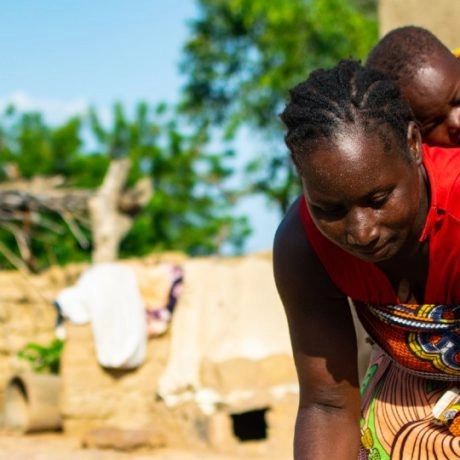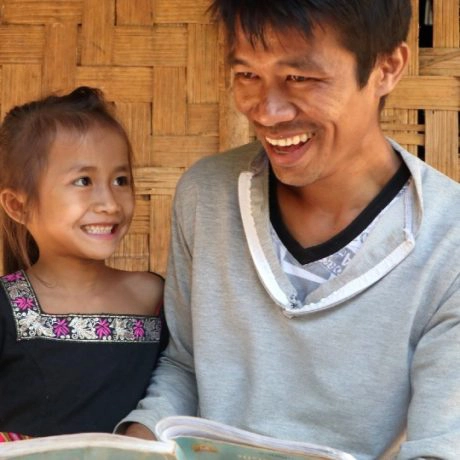News and Stories - Health - 6 April 2018
Raising healthy kids

Image: children receive a daily meal as part of our school feeding program in Cambodia. Our friends at Whole Kids are supporting kids in Cambodia to start their days with a healthy breakfast at school so they have the energy to learn!
Getting kids (and sometimes adults) excited about eating healthy food can be tricky. Whether it’s hiding the green vegetables on the plate or making up dances for vegies, most parents will try anything to make sure their kids are getting the nutrition they need.
In the lead up to World Health Day, we spoke with our partner Whole Kids Co-Founder & CEO Monica Meldrum, who shed some light on the important role health and nutrition plays in giving kids the best start to life.
Whole Kids creates a leading range of organic, additive-free and allergen-friendly snacks for kids, where proceeds go towards funding projects globally to improve the lives of children.
We asked Monica for some tips on how to make even the fussiest of eaters excited for a healthy meal and how you can best help your kids understand the importance of nutrition, along with some go-to recipes that you can easily fit into a busy week.
Why is healthy, nutritious food for kids so important?
Young children require energy to help them grow, develop and reach their full potential.
Providing optimum nutrition is on most parents’ minds and more research is highlighting the importance of nutrition in the early stages of life (conception to two years) and the risk of developing long-term chronic diseases. The first 1000 days of a child’s development is significantly affected by the biological and physical environments they occupy during this time. A child’s diet is such an important factor not only on their childhood health, but their future outlook.
Children represent a perfect opportunity to help shape a healthier, happier future. Parents are becoming more informed about both the short-term and long-term health effects of their kids’ eating choices. We have more parents who can see in their own children the effect that food has on their energy, behaviour and focus. The importance of eating real food is being demonstrated to us through the Whole Kids community with increasing reactions to artificial preservatives and colourings, and a rise in the number of food allergies in children.
My personal journey to want to be involved in improving children’s health and nutrition started in early 2000, after being chosen by the Department of Foreign Affairs (DFAT) to lead a team of 16 Australians to a remote village in Indonesia to deliver an aid program to children living in poverty. This experience had a profound impact on me and I vowed to use my skills and influence wherever I could to make a real and positive difference to children’s health.
Upon my return to Australia I observed that food related illnesses were on the rise, the incidence of childhood obesity was growing rapidly to unacceptable levels and rates of allergies amongst children were at an all-time high.
Products produced by big food companies were heavily processed, there was little regulation around the use of food additives, and marketing tactics used by these companies to hook kids and mislead parents was so wrong.
After partnering with industry experts including dieticians from the Royal Melbourne Children’s Hospital (RMCH), Australian Certified Organic (ACO) and leading manufacturers from Australia and New Zealand, and conducting a series of focus groups, I decided to tackle the issue head on. In 2005, together with my husband James, we used our entire life savings to develop and launch a range of nutritionally superior children’s snack products to sit alongside established multinational brands. We are using the proceeds to assist children in need and to campaign heavily to combat the misconceptions created by Big Food around what is good.
How can we encourage healthy eating for kids?
We all know we need to eat our fruit and veg but it is not always easy to ensure our little ones get enough each day. ‘Eating a rainbow’ is a great way to think about your daily fruit and veg intake as part of a healthy diet. Choosing fruits and veggies of different shapes, colours, textures and tastes will help incorporate variety and increase the likelihood of your child finding something that they are interested in eating. It is important to have fun with it and to create a positive experience around trying different things. Every parent will develop their own handful of off-the-wall tricks to encourage this. In our house we have ‘the broccoli dance’ – say no more. Be patient here and don’t be perturbed by your little one’s reaction to food if they don’t like it at first.
Children are like sponges and can be easily influenced by your likes and dislikes. Maintaining a positive attitude around healthy food and eating a healthy balanced diet yourself will set a good example for your children. Make meal times a positive experience and take time to sit down to eat together as a family.
How can we help kids have a healthy relationship with food?
I love to get in the kitchen with my kids and let them get hands on with cooking. It’s important for your children to know where food comes from and how it is put together so that they can appreciate the value of good food and to be able to make their own healthy food choices in the future.
As a family, we often go to the market and select the produce we cook with so that the kids can see what real food looks like; we talk about how it grows and how we can cook it. My son loves to cook and try new food in the process. It’s important to let them get their hands dirty, make a mess, use their creativity and enjoy the food as a family afterwards.
What are some staple foods parents can include in their kids’ diet?
Recently we have been looking at kindergarten and pre-school lunch boxes; what should go in them, how to make sure they are nutritious and most importantly; that they get eaten! Eating a healthy balanced diet at school with lots of water is important to keep energy levels up, increase concentration and prevent meltdowns.
What to put in your child’s lunchbox can be a tricky dilemma, particularly as it needs to be done five days a week, often for multiple children who like different foods.
Your children are more likely to have a balanced lunch if they have a main meal and snack which comprise of the different food groups – fruits, vegetables, grains, proteins and dairy.
Why these are important to your little ones is explained by our in-house nutritionist below:
Dairy
Dairy foods provide an excellent source of calcium which is important for children’s growth and development, particularly for strong, healthy bones.
Grain-based Foods
Grains are another important component of the diet, they provide an important source of carbohydrate as well as other vitamins and minerals. However, the type of grain is important – try to always choose whole grain or high fibre varieties of bread, cereal, rice, pasta or noodles. Foods high in refined grains, such as cakes and biscuits, should be limited as they can be high in added sugar, fat and salt.
Protein
Good protein sources include lean meats and poultry, fish, eggs, tofu, nuts and seeds. Protein is essential for children’s growth and development, particularly for their bones and muscles. It also helps build and repair tissues in the body. A healthy protein source should be a key part of every lunchbox for kids of all ages.
Fruit
Fruits are a great source of vitamins, minerals and dietary fibre all of which are highly important for maintaining health and good growth and development. Servings of fruit should be less than servings of vegetables – think of a 2:5 ratio.
Vegetables
Vegetables, legumes and beans are also a great source of vitamins, minerals and dietary fibre. They should make up a good proportion of each of your children’s meals and even make an excellent snacking option. Servings of vegetables should be higher than servings of fruit in a daily diet – think of a 5:2 ratio!
The Balance
A Balanced Lunch Box. As a rough guide try and proportion the above elements to:
25% Grains
25% Vegetables
15% Fruit
15% Protein
20% Diary
And don’t forget the water! It should be the main drink for your child.
This will vary with the age of the child and obviously every child has different tastes and dietary requirements, but this is a good ratio to keep in mind when you are packing your child’s lunch.”
How do you talk to your kids about issues impacting kids overseas like a lack of access to nutritious food?
Having seen first-hand children living in poverty during my work in Indonesia I know how important sustainable access to nutritious food is to a community. To be able to explain this to my family who always have good food and water available to them is difficult, especially when they are only 8 and 3 years old. What is easy for children to understand is equality. They tend to see the world in a much simpler and clearer light than adults. They recognise that children all over the world should have access to nutritious food because that is what is fair.
With my kids I try to explain that this is not always the case and help them to be grateful for what they have. I fill in a gratitude journal with my daughter so that she understands and appreciates this and understands how children overseas may be having a different experience.
I am hoping to be able to take my daughter to Cambodia later this year to visit The Plan International School Meals Projects so that she can experience this first hand. It is important to me that she has an appreciation of other cultures and global issues affecting other children of her age so that she can also grow up to try and affect change.
What’s a go-to recipe for busy parents?
One of my favourite summer recipes is Sweetcorn Fritters with Avocado Salsa. These amazingly yummy fritters are easy to whip up and are great for weekend family brunch. Adapt the recipe to suit your family, with poached eggs for breakfast, add tuna for protein at lunch, or ramp up the flavour of the salsa with coriander, olive oil and a pinch of salt.
Check out Monica’s Sweetcorn Fritters with Avocado Salsa
Recipe swapping is a great way of keeping up inspiration when trying to get your kids excited for healthy meals. If you’ve got a favourite go-to nutritious #kidfriendlymeal you’d like to share, let us know on social media.
We’re bringing together a community that is raising global citizens by sharing knowledge and experiences and empowering young people to reach their full potential. If you’d like to be a part of it, sign up here.




